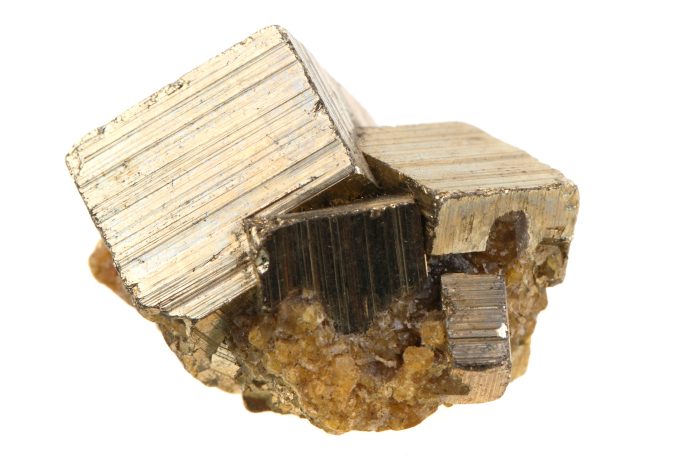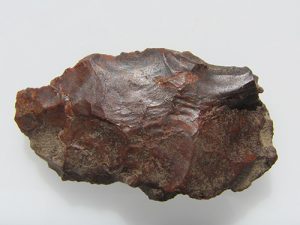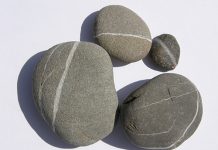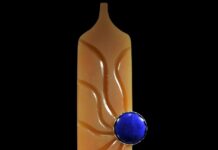
Flint and pyrite are more than just striking-looking minerals—they were once the literal spark behind humanity’s ability to create fire. For thousands of years, their unique hardness and chemistry made them indispensable tools in survival, weaponry, and exploration. From the Stone Age to the early modern era, these minerals shaped human history, with evidence of their use found in cultures worldwide.
Ötzi the Iceman’s Flint and Pyrite
One of the oldest and best-preserved human mummies ever found is that of Ötzi, a man who lived some 5,300 years ago near the present border of Austria and Italy. His remains, preserved in an alpine glacier high in the Ötztal Alps, were found in 1991. That Ötzi lived during the transition between the late Stone Age and the dawning Copper Age is evident from his possessions: a flint knife and a copper axe. Also among his possessions were pieces of flint and pyrite, the key materials of early percussion fire-making.
The Mineral Properties Behind Flint and Pyrite Sparks

Anthropologists believe humans first created artificial fire between 250,000 and 700,000 years ago using simple drills in which wood-on-wood friction generated ignition heat. Much later, they learned to make fire by striking certain mineral materials with hard objects.
The first mineral-sparking material was pyrite, or iron disulfide. The striking material was flint, a form of microcrystalline quartz. Harder than pyrite, flint could be easily shaped into a striking edge. When flint strikes pyrite, part of the pyrite surface shatters and emits a shower of sparks, which can ignite dry tinder.
It is uncertain when percussion fire making with pyrite began, but it was common in many cultures worldwide long before the time of Ötzi. It was quickly replaced during the early Iron Age when flint and steel became the preferred materials. Fire-making “kits” of flint and variously shaped steel strikers were still used by a few isolated cultures in the late 1800s.
Pyrite survived as a sparking material only into the 16th century, notably in wheel lock firearms, in which a mechanical arm securing a piece of pyrite was placed against a serrated steel wheel. When the trigger was depressed, the spring-driven wheel rotated rapidly, abrading the pyrite and delivering a shower of sparks to ignite the powder charge.
From Pyrite to Steel: The Evolution of Fire-Making Minerals
A big advance in weaponry came in 1570 with the invention of the flintlock firing mechanism, which employed shaped flints mounted on metal arms. Depressing the trigger moved the arm forward, striking the flint against an iron plate to produce sparks, which ignited the powder. During the 1700s, the manufacture of precisely shaped “gunflints” was an important industry in England and France. Both countries exported millions of gunflints each year around the world.
The introduction of modern percussion firing caps made gunflints obsolete in the 1830s. At the same time, the appearance of the friction-chemical match negated the need for other types of flint-steel percussion fire-making devices. By then, chemists had finally answered the centuries-old question of why pyrite and steel emitted sparks when struck with harder objects. The explanation was instantaneous chemical oxidation.
The Chemistry of Flint and Pyrite Ignition

Pyrite is unstable and undergoes slow oxidation, combining with water and atmospheric oxygen to break down into ions of iron and sulfur, which ultimately recombine into sulfuric acid and various iron hydroxides. This slow, natural process emits much heat—enough to warm the walls of pyrite-rich, underground mines.
In percussion fire making, hard, sharp flint shatters the pyrite surface into microscopic particles, breaking its covalent bonds and releasing heat. Now exposed to atmospheric oxygen, these already hot pyrite particles instantaneously oxidize and release even more heat. Because this heat is released too quickly to dissipate, it forms a shower of visible sparks.
A similar process occurs in flint-steel percussion. Because pure iron will not spark, fire-making requires harder, less brittle carbon steels. When struck with flint, the steel’s metallic bonds part, fragmenting the steel and releasing heat. These tiny particles of hot steel then contact atmospheric oxygen and undergo complete, instantaneous oxidation, releasing additional heat in the form of visible sparks.
Flint & Pyrite: Final Thoughts
Flint and pyrite demonstrate how specific mineral properties were harnessed for early fire-making. The hardness of flint allows it to fracture pyrite effectively, producing microscopic particles that rapidly oxidize and release heat. Ötzi, as he made his way across the Ötztal Alps some 5,300 years ago, had no knowledge of chemical oxidation, but he was nevertheless quite adept at making fire with dry tinder, flint and pyrite. This process illustrates the interplay between mineral structure, chemical reactivity, and practical application in human technology. Studying these minerals provides insight into both ancient survival techniques and the fundamental chemistry behind spark generation.
This article about flint and pyrite previously appeared in Rock & Gem magazine. Story by Steve Voynick. Click here to subscribe.















